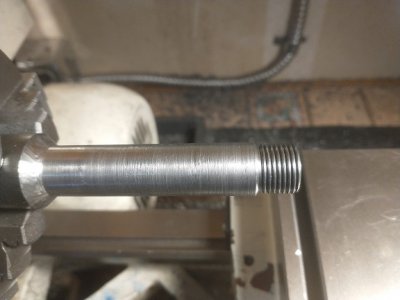Your interpretation is correct as far as I can tell. For a novice at threading, one must understand what threading actually is. I have a Grizzly G1550 which is almost identical to the Jet BD920, so I will present my thoughts from experience rather than theory. The lead screw is a 16 pitch, 16 TPI, screw. Therefore, if you want to cut a 16 TPI thread, the cutter must move 1/16 inch for one revolution of the spindle. The gear train is adjusted, gears changed as needed, to accomplish this as needed for the particular thread.
To cut metric threads, the gears are adjusted to move the lead screw in (sub)millimeters per revolution. This is accomplished by inserting a ratio of 127:120. The 127, a prime number, is the only conversion from imperial to metric. The 120 tooth gear could be a 100 tooth as well, although the 120 tooth allows divisions by 3. There are many gear combinations that yield "almost" metric threads, many to a factor of four decimal places. With the Modulus 1 gears, 25.4 DP, the 127 tooth gear is small enough to be usable.
When calculating the gearing required for a particular thread, the quick change (QC) box must be included in the calculations. As a starter project, the 127 tooth gear is removed, forming a spacer or buffer but not a portion of the reduction gears. Using a piece of plastic, 1/2 PVC is highly recommended, as a convenient material to practice. Set the machine up for 16 TPI and rotate the spindle by hand, watching the lead screw. The depth of cut is slight, just a few thousandths for each pass.
When cutting imperial threads (16 TPI, et al) the threading dial may be used. For cutting metric threads, the half nuts are never released. The machine is stopped, the cutter is backed out, and the machine reversed beyond the starting point. I do this for both imperial and metric simply because, as an old man, muscle memory for one process is easier to remember than two.
Once you are comfortable with cutting threads, imperial or metric, the range of small threads can be easily doubled on the down side, though not shown on the threading chart. Doubling on the upper side, coarser, is not recommended for such a small machine. The slowest speed, ~130 RPM, is a little too fast for threading close to the chuck. I built a 3:1 reducer that I will post in the archives, some day. But for the novice, it is simpler to rotate the chuck by hand. Twenty some years ago, there was a move on a board dedicated to these machines that advocated several methods for this, the most notable being a small steering wheel bolted to the spindle pulley.
Cutting Left Hand threads is also no big deal. The BD920 is not equiped to reverse the lead screw, although a tumbler reverse can be easily built. There are several iterations available on the Web. It is not an advanced project, but does require a little "finagling".
.


